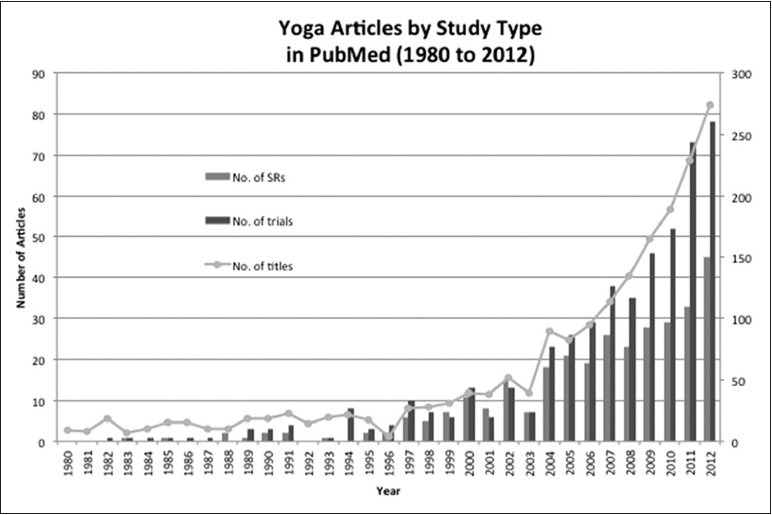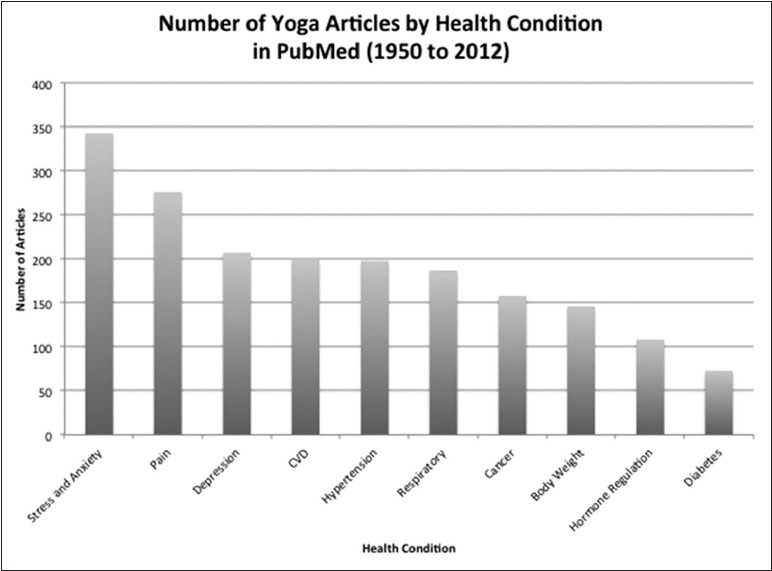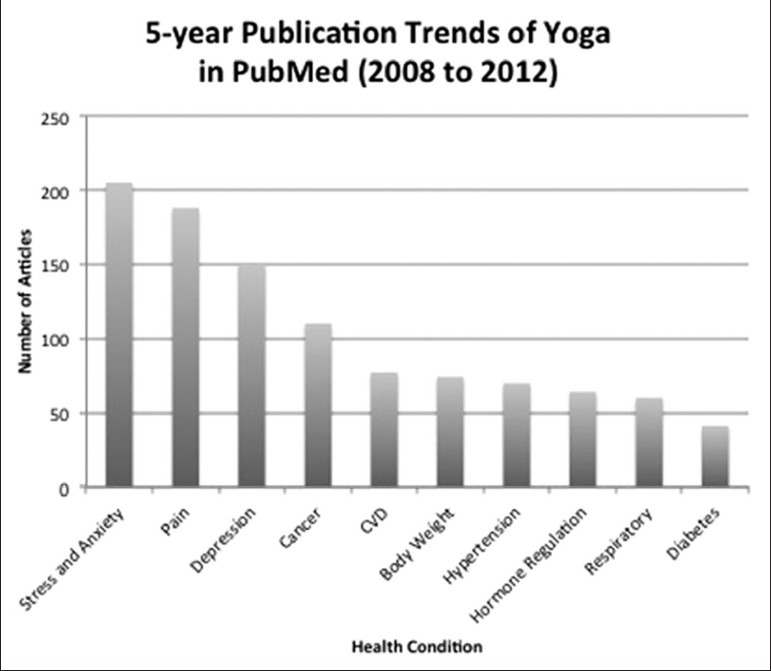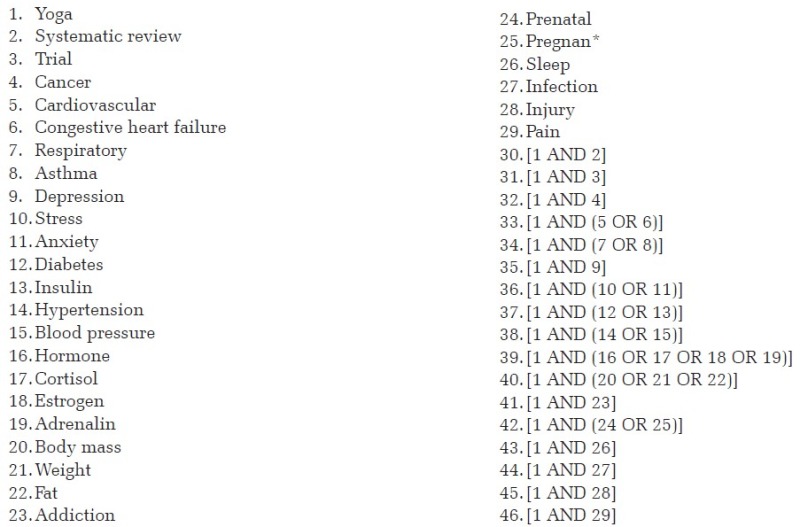Abstract
Context:
The promotion of yoga practice as a preventative and treatment therapy for health outcomes in the western hemisphere is increasing rapidly. As the commercial success of yoga burgeons in popular culture, it is important to investigate the trends of yoga as a therapeutic intervention in academic literature. The free-access search engine, PubMed is a preeminent resource to identify health-related research articles published for academics, health practitioners and others.
Aims:
To report the recent yoga-related publications in the western healthcare context with particular interest in the subject and type of yoga titles.
Materials and Methods:
A bibliometric analysis to describe the annual trends in publication on PubMed from January 1950 to December 2012.
Results:
The number of yoga-related titles included in the PubMed database is limited until a marked increase 2000 and steady surge since 2007. Bibliometric analysis indicates that more than 200 new titles are added per annum since 2011. Systematic reviews and yoga trials are increasing exponentially, indicating a potential increase in the quality of evidence. Titles including pain management, stress or anxiety, depression and cancer conditions are highly correlated with yoga and healthcare research.
Conclusions:
The prevalence of yoga research in western healthcare is increasing. The marked increase in volume indicates the need for more systematic analysis of the literature in terms of quality and results.
Keywords: Bibliometric, research, trends, west, yoga
INTRODUCTION
With origins in 5,000 B.C.E. India, yoga combines specific postures (asanas), breathing techniques (pranayama), meditative techniques (dhyana), chants (mantras), and wisdom teachings (sutras) to encourage health and relaxation.[1,2] Following the worldwide commercial success of yoga, industry reports an increase in yoga participation since 2005 with over 30 million people practicing yoga for health benefits daily.[3] As the number of yoga practitioners and yoga schools in the west increases, interpretations of the practice of yoga vary with several applications of spiritual, cultural, and therapeutic knowledge.[4] The National Institutes of Health (US) and National Health Services (UK) describe yoga as a safe and effective intervention to increase strength, flexibility and balance, and treatment for high blood pressure, heart disease, aches and pains, depression, stress, and potentially asthma.[5,6] The purpose of this study is to investigate the prevalence of yoga research by subject and type in the context of a western healthcare database. Specifically, as the popularity of yoga practice for health in western populations continues to increase, do publication trends in yoga research indicate a similar surge in interest?
MATERIALS AND METHODS
Bibliometric analysis of PubMed trends
A service offered by the National Library of Medicine (NLM), PubMed contains publication information of over 21 billion articles for biomedical literature with citations that include fields of biomedicine, behavioral sciences, chemical sciences and bioengineering.[7] This database is most commonly used to source relevant articles for health professionals and academics in the western hemisphere, primarily because of its subject focus, abundance of material and free-access to medical abstracts in the English language.
Research instrument
The annual statistics of PubMed results for yoga-related research is generated from an automated online tool[8] and key-term search strategy (Appendix A).
Inclusion and exclusion criteria
A preliminary analysis indicates the first recorded yoga article in PubMed dates to 1948 authored by E. Abegg with an unknown title,[9] while the first full-text yoga article appears to be written for 1964.[10] Therefore, to ensure a comprehensive and pragmatic search any yoga-related publication from the years 1950 to 2012 is included. Any citation that is not included on the PubMed search tool will be excluded and considered a limitation of the research.
RESULTS
Number of articles by research type
The total number of yoga-related articles listed on the PubMed database from 1950 to 2012 is 2,099. Of these titles, 498 (24%) include ‘yoga trials’ and 324 (15%) ‘Systematic Reviews’ [Figure 1].
Figure 1.

Yoga titles by type on PubMed
Research trends
Two yoga-related articles are published in 1950, with a cumulative total of seven titles until 1960. In 1961, seven further articles are added with annual additions of two to 13 articles until 1973. This trend of less than 20 new articles per year continues until 1991 with the exception of 3 years (1973-1975), [Figure 1]. The number of yoga publications in PubMed more than doubles between 1995 and 2000 from 17 to 39. The rate of publication following 2000 is sporadic until a surge in 2007 when 114 yoga titles are added to PubMed in one year. A steady increase in yoga research is indicated since 2007 with an increased rate of publication by at least 24 articles per year. From 2010 to 2012, 189, 229 and 274 new yoga-related articles are added per year. Of all yoga-based literature on PubMed, 47.2% (992) articles have been added in the past 5 years.
Number of articles by health condition
The results of the key term search indicate a vast majority (90.3%) of all yoga research is associated with 10 health conditions. The most prevalent health conditions for yoga study are stress/anxiety (343), pain (276), depression (207), cardiovascular disease (200), and blood pressure/hypertension (198). Respiratory conditions, cancer, body weight, hormones, and diabetes also indicate high association with yoga research [Figure 2]. Sleep, addiction, prenatal care, infection, and injury appear to have less association with yoga research (cumulative <5%).
Figure 2.

Yoga titles on PubMed by health condition (1950-2012)
DISCUSSION
Topics and earlier publications of yoga
The first recorded yoga article in western medical research dates to 1948, authored by E. Abegg with an unknown title.[9] The first full-text article found (1964) explores oxygen consumption during yoga-type breathing patterns.[10] Yoga research in the first 30-years of study includes diverse topics such as metabolism,[11] arterial blood gases,[12] body composition[13,14] bronchial asthma[15] and hypertension.[16] The body of literature still comprises largely of 10 health conditions, thought the recent 5-year trend indicates a shift in focus. See [Figure 3]. Stress/anxiety, pain, and depression remain the most prevalent, with cancer now exceeding the number of articles of hypertension, respiratory conditions, and cardiovascular disease [Figure 3]. In 2012 publications, 53% of all publications relate to stress/anxiety (21%), pain conditions (17%), and depression (15%), while 37 new articles in cancer (12%) indicates an area of emerging interest.
Figure 3.

5-year publication trends on PubMed by health condition
Limitations
This bibliometric analysis employs a gross method to observe the annual trends of yoga citations in one medical database. The ‘Systematic Reviews’ and ‘Trial’ abstracts are not assessed for content validity. As the results of yoga and health conditions are not investigated, no conclusions in terms of the direction of correlation can be drawn from this study.
CONCLUSION
The number of yoga-related publications on PubMed remains relatively low until 2000. A surge of yoga's popularity in western culture in 2005 is matched with academic interest in 2007. There are now over 2,000 yoga titles on the database, with a rate of more than 200 additions per year. Systematic reviews and yoga trials are increasing, indicating a potential increase in quality of evidence. Three conditions show consistently high correlations with yoga research: stress/anxiety, pain, and depression. A significant rise in the number of cancer publications suggests an area of emerging research. Investigation into the quality and direction of these findings would assist in understanding the potential impact of yoga on several predominant health conditions.
APPENDIX A: Key terms of search strategy

Footnotes
Source of Support: Nil
Conflict of Interest: None declared
REFERENCES
- 1.Oxford Dictionaries: “Yoga”. [Last accessed on 2012 May 1]. Available from: http://www.oxforddictionaries.com/definition/yoga?q=yoga .
- 2.Satchidananda SS, translator. The yoga sutras of Patanjali. 15th ed. Yogaville, Virginia, US: Integral Yoga Publications; 2010. p. 13. [Google Scholar]
- 3.Dangerfield A. Yoga wars. BBC news magazine 23 January 2009. [Last accessed on 2012 Mar 3]. Available from: http://www.news.bbc.co.uk/1/hi/7844691.stm .
- 4.Hoyez AC. The ‘world of yoga’: The production and reproduction of therapeutic landscapes. Soc Sci Med. 2007;65:112–24. doi: 10.1016/j.socscimed.2007.02.050. [DOI] [PubMed] [Google Scholar]
- 5.National Institutes of Health. Yoga for health. [Last accessed on 2012 May 3]. Available from: http://www.nccam.nih.gov/health/yoga/introduction.htm .
- 6.A Guide to Yoga. Choices: Your health, your choices. [Last accessed on 2012 May 1]. Available from: http://www.nhs.uk/livewell/fitness/pages/yoga.aspx .
- 7.Bethesdon MD. PubMed help: PubMed FAQs. [Last accessed on 2012 April 12]. Available from: http://www.ncbi.nlm.nih.gov/books/NBK3827/#pubmedhelp .
- 8.Alexandru DC. Medline trend: Automated yearly statistics of PubMed results for any query 2004. [Last accessed on 2013 Feb 8]. Available from: http://dan.corlan.net/medline.trend.html .
- 9.Abegg E. Ciba Z (Basel) 1948;10:4156. [PubMed] [Google Scholar]
- 10.Miles WR. Oxygen consumption during three yoga-type breathing patterns. J Appl Physiol. 1964;19:75–82. doi: 10.1152/jappl.1964.19.1.75. [DOI] [PubMed] [Google Scholar]
- 11.Hollmann W, Mukerji GS, Spiegelhoff W. Metabolism, respiration and circulation in yoga exercises. Dtsch Med Wochenschr. 1956;81:675–6. doi: 10.1055/s-0028-1115761. [DOI] [PubMed] [Google Scholar]
- 12.Pratap V, Berrettini WH, Smith C. Arterial blood gases in Pranayama practice. Percept Mot Skills. 1978;46:171–4. doi: 10.2466/pms.1978.46.1.171. [DOI] [PubMed] [Google Scholar]
- 13.Madhavi S, Raju PS, Reddy MV, Annapurna N, Sahay BK, Kumari DG, et al. Effect of yogic exercises on lean body mass. J Assoc Physicians India. 1985;33:465–6. [PubMed] [Google Scholar]
- 14.Bera TK, Rajapurkar MV. Body composition, cardiovascular endurance and anaerobic power of yogic practitioner. Indian J Physiol Pharmacol. 1993;37:225–8. [PubMed] [Google Scholar]
- 15.Jain SC, Talukdar B. Evaluation of yoga therapy programme for patients of bronchial asthma. Singapore Med J. 1993;34:306–8. [PubMed] [Google Scholar]
- 16.Anand MP. Non-pharmacological management of essential hypertension. J Indian Med Assoc. 1999;97:220–5. [PubMed] [Google Scholar]


